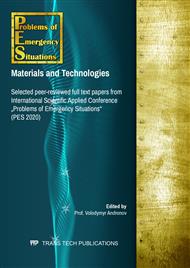[1]
João A. Freire, Gonçalo C. Rodrigues, Margarida Tomé, Climate Change Impacts on Pinus pinea L, Silvicultural System for Cone Production and Ways to Contour Those Impacts: A Review Complemented with Data from Permanent Plots, Forests. 10 (2) (2019) p.169.
DOI: 10.3390/f10020169
Google Scholar
[2]
Maria Margarida Ribeiro, Nata´lia Roque, Sı´lvia Ribeiro, Catarina Gavinhos, Isabel Castanheira, Luı´s Quinta-Nova, Teresa Albuquerque, Saki Gerassis, Bioclimatic modeling in the Last Glacial Maximum, Mid-Holocene and facing future climatic changes in the strawberry tree (Arbutus unedo L.), PloS ONE, 14(1) (2019) 21-62.
DOI: 10.1371/journal.pone.0210062
Google Scholar
[3]
O. Rybalova, K. Korobkina, Vplyv lisovykh pozhezh na stan vodnykh ecosystem, 5 Mizhnarodnyi konhres, Zakhyst navkolyshnoho seredovyshcha. Enerhooshchadnist. Zbalansovane pryrodokorystuvannia: zbirnyk materialiv, Lviv, (2018) s.199 [in Ukrainian].
Google Scholar
[4]
Y. Danchenko, V. Andronov, M. Teslenko, V. Permiakov, E. Rybka, R. Meleshchenko, A. Kosse, Study of the free surface energy of epoxy composites using an automated measurement system, EasternEuropean Journal of Enterprise Technologies. 1 (12-91) (2018) 9-17.
DOI: 10.15587/1729-4061.2018.120998
Google Scholar
[5]
K. Mygalenko, V. Nuyanzin, A. Zemlianskyi, A. Dominik, S. Pozdieiev, Development of the technique for restricting the propagation of fire in natural peat ecosystems, EasternEuropean Journal of Enterprise Technologies, 1 (10-91), (2018) 31-37.
DOI: 10.15587/1729-4061.2018.121727
Google Scholar
[6]
D. Dubinin, K. Korytchenko, A. Lisnyak, I. Hrytsyna, V. Trigub, Improving the installation for fire extinguishing with inelydispersed water, EasternEuropean Journal of Enterprise Technologies. 2 (10-92) (2018) 38-43.
DOI: 10.15587/1729-4061.2018.127865
Google Scholar
[7]
I. Dadashov, V. Loboichenko, A. Kireev, Analysis of the ecological characteristics of environment friendly fire fighting chemicals used in extinguishing oil products, Pollution Research. 37 (1) (2018) 63-77.
Google Scholar
[8]
H. Ivanets, S. Horielyshev, M. Ivanets, D. Baulin, I. Tolkunov, N. Gleizer, A. Nakonechnyi, Development оf combined method for predicting the process of the occurrence of emergencies of natural character, Eastern-European Journal of Enterprise Technologies. (2018).
DOI: 10.15587/1729-4061.2018.143045
Google Scholar
[9]
A. Vasenko, O. Rybalova, O. Kozlovskaya, A study of significant factors affecting the quality of water in the Oskil River (Ukraine) EasternEuropean Journal of Enterprise Technologies. 3 (10-81) (2016) 48-55.
DOI: 10.15587/1729-4061.2016.72415
Google Scholar
[10]
O. Rybalova, S. Artemiev, Development of a procedure for assessing the environmental risk of the surface water status deterioration, Eastern-European Journal of Enterprise Technologies, 5 Issue 10 (89) (2017) 67–76.
DOI: 10.15587/1729-4061.2017.112211
Google Scholar
[11]
O. Rybalova, S. Bielan, Zakhody shchodo zmenshennia vplyvu lisovykh pozhezh na ekolohichnyi stan malykh richok, Vostochno-Evropeiskyi zhurnal peredovykh tekhnolohyi, 6/8 (54) (2011) 52 – 57 [in Ukrainian].
Google Scholar
[12]
Y. Buts, Dynamika landshaftnykh pozhezh v Ukraini ta ekoloho-ekonomichni naslidky yikh vynyknennia, Visnyk ONU. Ser.: Heohrafichni ta heolohichni nauky. 18,2(18) (2013) 111 – 117 [in Ukrainian].
Google Scholar
[13]
Yufei Zou, Yuhang Wang, Yun Qian, Hanqin Tian, Jia Yang, Ernesto Alvarado, Using CESM-RESFire to understand climate–fire–ecosystem interactions and the implications for decadal climate variability, Atmos. Chem. Phys. 20 (2020) 995–1020.
DOI: 10.5194/acp-20-995-2020
Google Scholar
[14]
Ø. Hodnebrog, S. Solberg, F. Stordal, T. M. Svendby, D. Simpson, M. Gauss, A. Hilboll, G. G. Pfister, S. Turquety, A. Richter, J. P. Burrows, H. A. C. Denier van der Gon, Impact of forest fires, biogenic emissions and high temperatures on the elevated Eastern Mediterranean ozone levels during the hot summer of 2007, Atmos. Chem. Phys. 12 (2012) 8727–8750.
DOI: 10.5194/acp-12-8727-2012
Google Scholar
[15]
X. Yue1, L. J. Mickley, J. A. Logan, R. C. Hudman, M. V. Martin, and R. M. Yantosca, Impact of 2050 climate change on North American wildfire: consequences for ozone air quality, Atmos. Chem. Phys. 15 (2015) 10033–10055.
DOI: 10.5194/acp-15-10033-2015
Google Scholar
[16]
Rocío Baró, Laura Palacios-Peña, Alexander Baklanov, Alessandra Balzarini, Dominik Brunner, Renate Forkel, Marcus Hirtl, Luka Honzak, Juan Luis Pérez, Guido Pirovano, Roberto San José, Wolfram Schröder, Johannes Werhahn, Ralf Wolke, Rahela Žabkar, Pedro Jiménez-Guerrero, Regional effects of atmospheric aerosols on temperature: an evaluation of an ensemble of online coupled models, Atmos. Chem. Phys. 17 (2017) 9677–9696.
DOI: 10.5194/acp-17-9677-2017
Google Scholar
[17]
O. Rybalova, S. Artemiev, M. Sarapina, B. Tsymbal, A. Bakharevа, O. Shestopalov, O. Filenko Development of methods for estimating the environmental risk of degradation of the surface water state, EasternEuropean Journal of Enterprise Technologies. 2/10 (92) (2018) 4-17.
DOI: 10.15587/1729-4061.2018.127829
Google Scholar
[18]
P. C Nagajyoti, K. D. Lee, T. V. M. Sreekanth,. Heavy metals, occurrence and toxicity for plants: a review, Environ. Chem. Lett. 8 (2010) 199–216.
DOI: 10.1007/s10311-010-0297-8
Google Scholar
[19]
S. Niassy, K. Diarra, Effect of organic inputs in urban agriculture and their optimization for poverty alleviation in Senegal, West Africa, Organic Fertilizers: Types, Production and Environmental Impact, ed R. P. Singh (Hauppauge, NY: Nova Science Publisher). (2012) 1–22.
Google Scholar
[20]
J. Schimel, T. C. Balser, M. Wallenstein, Microbial stress-response physiology and its implications for ecosystem function, Ecology. 88 (2007) 1386–1394.
DOI: 10.1890/06-0219
Google Scholar
[21]
Y.P Wang, J.Y. Shi, H. Wang, Q. Lin, X C. Chen, Y.X. Chen. The influence of soil heavy metals pollution on soil microbial biomass, enzyme activity, and community composition near a copper smelter, Ecotoxicol. Environ. 67 (2007) 75–81.
DOI: 10.1016/j.ecoenv.2006.03.007
Google Scholar
[22]
C. O. Nwuche, E. O. Ugoji, Effects of heavy metal pollution on the soil microbial activity, Int. J. Environ. Sci. Technol. 5 (2008) 409–414.
DOI: 10.1007/bf03326036
Google Scholar
[23]
O.V. Rybalova, O.V. Bryhada, K.M. Korobkina, O.M. Krainiukov, I.M. Miroshnychenko, Vyznachennia nebezpeky vplyvu lisovykh pozhezh na yakisnyi stan gruntiv, Naukovyi visnyk budivnytstva. 2(96). (2019) 413-422 [in Ukrainian].
Google Scholar
[24]
S. Parwinder, Wooster Grewal, (OH) US; Edward L. McCoy, Wooster (OH) US; Warren A. Dick, Wooster (OH) US, Hanbae Yang, Wooster (OH) US., The Ohio State University, Columbus, OH, US. Patent 7967979 B2, USA. Bi-phasic bioretention system.
DOI: 10.21236/ada540405
Google Scholar
[25]
Anton Matsak, Kateryna Tsytlishvili, Olga Rybalova, Sergey Artemiev, Andrey Romin, Oleksandr Chynchyk, Method of agricultural sewage water purification at troughs and a biosorption bioreactor, Eastern European Journal of Enterprise Technologies. 5, 10 (95) (2018) 15-25.
DOI: 10.15587/1729-4061.2018.144138
Google Scholar


